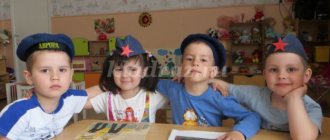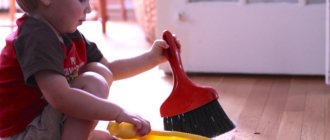What should gender education be like in kindergarten?
You need to understand that gender education is a long and varied process. It begins in the family, continues in preschool and school, and ends only when the child has lived about two decades of his life. You should not expect that all the work on developing competent gender self-identification, teaching gender roles and relationships for a preschooler will be done by kindergarten teachers.
At the same time, gender approaches in preschool educational institutions can significantly contribute to these processes. There are several main directions and aspects of gender education in preschool educational institutions:
- Thematic conversations. Children can look for each other's commonalities and differences, discuss what it means to be a girl, what it means to be a boy, and so on. Speech is the most important learning tool, and not using it for gender education in kindergarten would be blasphemy.
- Games with gender roles. Girls want to be ballerinas and actresses, boys want to be pilots and programmers. Girls like to dress up dolls in dresses, boys like to line up soldiers on the edge of the table and crush an imaginary enemy. Games that combine girlish and boyish preferences, allowing them to express their femininity and masculinity, may seem too banal and categorical from an adult point of view, but for children they are very important and useful.
- Reading fairy tales, word games, acting out skits and other ways to create associations with characters of the same gender. A girl who has no problems with gender self-identification will associate herself with Mashenka, a kitty, a fox, and so on. The boy is with Petya, the prince, the bear, etc. And the point here is not in attributing to oneself the characteristics of the character, but, for example, in acting out his role in the scene. The teacher should help children understand such things at first.
- A competent approach to conducting physical education classes. A good kindergarten physical teacher will give boys more strength exercises, and when working with girls, focus on aerobics and gymnastics. Of course, no one will stop a girl who has grown into a beautiful girl from going to the gym, just as no one will stop a boy from doing acrobatics. But in the early years, in a kindergarten, such a division by type of exercise is most justified both in the context of the characteristics of the physical development of girls and boys, and in connection with the needs of their gender education.
- Proper distribution of tasks when conducting dance classes, matinees, and organizing performances. So, if we are talking about dancing, then girls should perform smooth and soft movements, while boys can set the rhythm and lead their little partners. Of course, when distributing costumes, the guys, again, must choose characters of their own gender.
The project is on the theme “We are so different”, focusing on gender education.
The Federal State Educational Standard for Preschool Education provides for the organization of educational activities for preschoolers to assimilate the norms and values accepted in society, the development of communication and interaction of the child with both peers and adults; formation of readiness for joint activities with peers; developing a respectful attitude and a sense of belonging to one's family and community of children and adults.
As part of the implementation of the tasks of the educational field “Socio-communicative development”, I have summarized my experience on the topic “We are so different”, the focus is gender education.
Describing the relevance of the experience, it should be noted that
The modern stage of modernization of education is accompanied by a rethinking of the goals and objectives, norms and values of the educational process, which entails the emergence of new approaches to the problem of socialization and individualization of the younger generation. One of the conditions for the effectiveness of socialization is a gender approach.
The prerequisites for a gender approach in pedagogy (A.A. Mudrik, E.H. Kamenskaya, E.V. Bondarevskaya, G.G. Kravtsov, etc.) are:
1. Breaking the traditional system of gender stratification, weakening the female and male polarization of social roles: the traditional gender division of labor has lost its rigidity and normativity.
2. Changing cultural stereotypes of masculinity and femininity, which become less polar.
3. Objective changes in marriage and family relations are observed: a) a new gender quality of marriage and family relations is emerging; b) there are positive changes in the marital and family status of men, which are expressed in the loss of the “breadwinner” function and a progressive decline in the socialization role of fatherhood.
4. Widespread feminization of education (home, preschool, school and university). The “feminization” of raising children has contributed and continues to contribute to the fact that many young people, due to their lack of the necessary qualities, experience additional difficulties when serving in the army; when they get married, they find themselves unable to perform basic men’s work and often shift responsibility onto the shoulders of women for family and upbringing children, which gives rise to many family conflicts. Female representatives do not develop patience, the ability to maintain the warmth of the family hearth, create a positive emotional mood in the family, or rationally and skillfully organize the household. The lack of gender education leads to an increase in divorces, a decrease in the birth rate, and an increase in the number of marriages that have not yet broken up, but are unstable.
According to data from the department of preschool education of the Federal Institute for Educational Development (FIRO), collected on the basis of an analysis of specialized literature, the following can be noted:
— for boys, at all stages of the formation of gender stability, additional efforts are required, without which development automatically follows the female type;
- masculine qualities are traditionally valued higher than feminine ones, and the pressure on boys in the direction of defeminization is much stronger than on girls in the direction of demasculinization (a feminine boy causes disapproval and ridicule, while a masculine girl is perceived positively);
- at an early age, boys and girls are under the influence of mothers and women in general, therefore, with age, boys need to be reoriented to male patterns of behavior, because Gender atypical behavior in childhood has many negative consequences.
The need for a gender approach is widely recognized in society. However, an analysis of mass practice has shown that serious problems are currently arising in the preschool education system:
— software and methodological support takes into account the age and psychological characteristics of children in general, without taking into account gender;
— strategies, forms and methods of working with children used in kindergarten are most often designed for girls. A female teacher does not have childhood experience of the experiences that boys face.
The implementation of the concept of gender education for preschool children requires compliance with the following psychological and pedagogical conditions for the effective education of boys and girls in the process of their gender socialization. I include:
– creation of a gender-comfortable educational space;
– development and implementation of gender education methods in the educational process;
– professional and pedagogical readiness of teachers for this activity;
– information and methodological support for parents on issues of gender identification and self-realization of the personality of boys and girls.
Observations of the children in my group showed that many girls lack modesty, patience, tenderness, do not know how to peacefully resolve conflict situations, and try to dominate boys. Boys cannot stand up for themselves, lack emotional stability, and they lack a culture of behavior towards girls. In role-playing games, children build models of behavior that are not characteristic of the child’s gender.
Based on the results of observations, I developed, implemented and generalized my experience on the topic “We are so different.”
Target:
Creating conditions for raising children of different sexes and their gender socialization.
Tasks:
For pupils:
— Creation of a developing subject-spatial environment in the group, taking into account the interests of boys and girls;
— Lay the foundations for future social and gender roles, cultivate a positive attitude towards different social gender roles.
For teachers:
— To increase the professional competence of teachers in matters of gender education for preschoolers.
For parents:
— Increase the level of competencies and the role of the family in gender education of preschool children.
Hypothesis
The implementation of the project “We are so different” will allow us to unite the efforts of preschool educational institutions and families in matters of gender education for preschool children.
Expected results
In children
— Determination of gender position in relation to the surrounding world and people through gaming activities;
— Development of the child as an individual in society and family, formation of a sense of masculinity (femininity);
— The desire to reflect one’s feelings in artistic and creative (productive) activities.
From parents
— Increasing the level of parents’ competencies in matters of gender education; manifestation of the transition from the position of partners to the position of active participants in the educational process.
From teachers
— Development and introduction into the educational process of a set of teaching materials for secondary group students on gender education.
— Increasing professional competence in gender education issues.
Content
Stage 1. Organizational
- Conducting a survey of parents to identify the characteristics of raising boys and girls in the family.
- Carrying out with children:
- pedagogical diagnostics using conversation methods (children were asked to answer the questions: - Who are you - a girl or a boy? - What games do girls (boys) play? - When you grow up, will you be a mother or father? - Who is the strongest in your family? – Who is the most beautiful in your family?, etc.);
— test tasks (“Choose a toy”, “Name whose things”, “Continue the story”, “Draw a person”, etc.);
— observations of the child’s behavior in everyday life, the child’s behavior in play activities.
The purpose of conducting pedagogical diagnostics —
to identify children’s knowledge about their present and future gender roles, to identify the peculiarities of the child’s perception of himself as a representative of a certain gender.
- Questioning teachers, studying methodological literature on the topic of the project.
The results of a survey of parents showed that only 10% of the parent community are competent in matters of gender education of children. The activity of parents in participation in the educational process of the group was 25%.
The level of development of gender identity of students according to the results of pedagogical diagnostics was 8.5%.
The results of a survey of teachers showed that only 35% of teachers have professional competence in issues of gender education of children.
Stage 2. Basic
Upon completion of processing the results of the first stage of the project, an algorithm for working with both children and their parents, as well as with the teachers of our kindergarten, was determined.
The algorithm for working with children reflected the following types of activities:
- conversations (“There are a lot of girls and boys in our group”, “What kind of girls (boys) do we have”, “Who am I?” “What am I?”);
- reading fiction (A. Barto “Vovka the Good Soul”, “Lyubochka”, V. Oseeva “Blue Leaves”);
— productive activities (“Portrait of a girl (boy)”, “Gifts for girls (boys)”), etc.;
— didactic games (“Mood”, “Let’s get to know each other”);
- looking at illustrations;
- stories from the teacher;
— role-playing games (“Family”, “Kindergarten”, “Shop”, etc.).
To work with the parent community, thematic parent meetings were planned on the topics “What is gender education?” “Let's talk about raising girls and boys”, etc.; design of stands “How and what boys and girls play”, “Age-related characteristics of the mental development of boys and girls”, etc.; holding joint events with children “The Most-The Most...”, “In the Pink Kingdom of Princesses”, etc., releasing video magazines “We Live Fun Together!”; thematic exhibitions: “Books about boys and for boys”, “Books about girls”, “Portrait of a mother”, “Portrait of a dad”, “My favorite toy” (selection of toys for boys and girls); photo albums “About our boys”, “About our girls”, “Family holidays” were created.
In order to form gender identity, parents were recommended works to read at home with their children - fairy tales, works based on epics, stories about defenders of the Fatherland, poems by S. Ya Marshak “Fire”, “The Story of an Unknown Hero”, from which children learned about such qualities masculinity, such as courage, perseverance, responsibility, willingness to help the weak, chivalry, inherent not only in adult men, but also in boys.
Together with a teacher-psychologist, work was carried out with parents who are raising children in single-parent families. Children who are raised in single-parent families often receive a distorted example of social skills in terms of gender role identification. If a boy is raised by one mother, then this contributes to the fact that the child does not lay the foundations of the social and moral behavior of a future man in preschool childhood; the boy imitates the social role played by his mother. In the future, such children experience certain difficulties in terms of social adaptation. Girls from single-parent families (a child is raised by one mother) generally do not face such problems - they imitate their mother, whose social role is characteristic of the future woman.
Parents raising children in single-parent families were provided with practical assistance by the educational psychologist in mastering the skills of gender education of children - problematic situations were considered, trainings were conducted, and lecture material was offered.
The content of the second stage of the project determined the model of gender education for preschool children in my group.
The results of the work at the second stage showed that in all three areas of activity - children, parents, teachers - there is a steady positive trend.
If at the first stage of work the results of the survey showed that the majority of children found it difficult to determine their present and future gender roles, to understand their own image of “I”, and perceive themselves as a representative of a certain gender, then at the end of the second stage the children confidently and firmly answered the test questions , performed test tasks, showing a high level. Observations of children's behavior in role-playing games, in everyday life, and analysis of productive activities also show positive dynamics in the development of gender identification of boys and girls.
Parents' satisfaction with the experience gained in gender education issues and the increase in the level of their competencies in this area were shown by high results of the survey.
As a result of the work done, psychological and pedagogical conditions were created, where the main role was given to work with teachers and the activities of the teachers themselves:
— training teachers to implement gender education activities;
— creation of a developing subject-spatial environment, gender-balanced space;
— development and implementation of gender education technologies in the educational process;
— providing advisory assistance to parents on issues of gender identification and self-realization of the personality of boys and girls.
Stage 3. Final
At the third stage, the results of the project were summed up:
Positive dynamics in the level of parents’ competencies in gender education of preschool children
The activity of parents in participating in the educational process of the group has increased significantly:
Increasing the activity of parents as part of their participation in the educational process of the middle group
Pedagogical diagnostics were carried out with the pupils of the group using the same methods that were used at the first stage of the project. We had the opportunity to compare the results of the first and second series of pedagogical diagnostics. We were pleased with the results.
Positive dynamics in the development of gender identification among middle group students
The level of professional competence of teachers on gender education issues is shown in the diagram:
Positive dynamics in the level of professional competence of teachers in matters of gender education
Analyzing the experience of working on gender education, we can conclude that in our kindergarten, and specifically in my group, conditions have been created that contribute to the gender socialization of children, and a model of gender education for preschool children has been created. The developing subject-spatial environment is equipped taking into account the gender socialization of children: play areas for girls and boys with a certain set of toys and games have been created, game modules “Kitchen”, “Workshop”, etc. have been purchased. The level of psychological and pedagogical competence of educators in matters of gender education for preschoolers has increased significantly. The novelty of the experience lies in the fact that the developed technologies for educating girls and boys in relation to each age group will be used in practical activities in a specific system.
The role of the family in gender education of children has increased. The children's horizons have expanded and been enriched with knowledge about the content of the social roles of women and men. The level of cultural behavior and communication among children has increased noticeably: boys have become more attentive towards girls, and girls have become more friendly towards boys.
The experience of working on the project “We are so different” was summarized and presented by me at the pedagogical council of MBDOU d/s No. 10 “Solnyshko” in October 2020. On the basis of our kindergarten, a methodological association was held for teachers of the Peschanokopsky district (December 2020), where I presented my experience in gender education of preschoolers.
Considering that in January 2020 our preschool educational institution was awarded the status of a Regional Innovation Platform on the topic “Gender education in a preschool educational organization,” the experience I have gained will be the basis for a future project and will receive further development and improvement.
Why is gender education of preschoolers important?
Gender education of children in general and preschool children in particular is important not only because it will be easier for them to fit into society if they feel comfortable playing appropriate gender roles. It is also important because the differences between genders are very real, objective and not at all far-fetched.
Men and women really have different physiology, perceive information differently, process it differently, tend to behave differently, think differently, and so on.
You may have heard about an experiment in the second half of the twentieth century, when a boy named Bruce, who was unsuccessfully circumcised, was decided to be castrated completely and raised as a girl, Brenda. The author of this experiment, John Money, wanted to prove that the behavioral characteristics of men and women depend solely on their upbringing, on what they are taught to do from early childhood.
Despite everything, Brenda, born Bruce, behaved like a typical boy, and even giving him/her estrogen did not help. This unfortunate man refused sex reassignment surgery, tried to commit suicide three times, and at the age of 32 he regained his male sexual characteristics and started a family. However, after the divorce, he still committed suicide at the age of 38.
Since then, many studies have been conducted that clearly prove that the differences between men and women are not only in physiology, but also in the characteristics of higher nervous activity, in the functioning of the psyche, in behavior, etc. And ignoring these differences is extremely absurd.
Experience in developing the gender identity of older preschoolers
Natalia Gritsenko
Experience in developing the gender identity of older preschoolers
An important condition for the formation of gender identity in older preschoolers is the creation of a multifunctional subject-development environment that surrounds boys and girls.
Slide number 2. The necessary elements of the subject-development environment, in addition to the generally accepted ones , are:
action schemes reflecting cultural standards of behavior for male and female representatives; cards-symbols of goodness, beauty, honesty, courage, strength, etc., denoting the socially valuable qualities of a boy and a girl; " and so on.,
a beauty corner that allows the child to clean up his appearance independently without prying eyes;
mini-environment of social etiquette (“Theater”, “Dinner Party”, “Concert”, “Strangers”, “Reception of Guests”, etc., where suits, hats, bow ties, ties, flowers, books and etc., providing the child with the opportunity to independently play a variety of male and female roles.
a mini-environment of male and female labor, containing equipment necessary for the formation of male and female skills (workshops with sets of plumbing, carpentry, construction tools; agricultural implements; sewing accessories , fragments of a kitchen unit, bathroom, etc.);
model of a Russian hut, house decoration: table, bench, bench (bench with a back, tables (stools, chests, cradle, spinning wheel, etc.);
attributes representing male and female professions (portraits of people of different professions, elements of clothing, professional accessories , books telling about people of different professions);
senior preschool groups, boys and girls enjoy playing role-playing games “Family”
,
“Mothers and Daughters”
,
“School”
,
“Hospital”
,
“Shop”
,
“We are expecting guests”
.
Slide No. 4 A huge role in the development of play activity belongs to the construction of large building materials. In our group, the boys willingly design for group games. It could be a large car, an airplane, a steamship, a train carriage, etc. etc. At the same time, a very important condition for raising children, taking into account their gender characteristics, is that we entrust boys with “hard”
work , for example: “driving”
material on cars, installing the main large parts, etc. etc.
In my work with children of senior preschool age, I use the following technologies of gender role education:
1. Slide No. 5 Technologies that contribute to the formation of gender-role knowledge and ideas: ethical conversations, symbolic games (game methods of PM Chumicheva)
2. Slide No. 6 Technologies that promote mastery of gender-role behavior: problem situations, dramatization games, communicative games.
3. Slide No. 7 Technologies that contribute to the education of femininity and masculinity, self-improvement of women (men)
individuality: competition games
“Knight's Tournament”
,
“Little Housewife”
4. Slide No. 8 Technologies that determine the formation of boys and girls’ ideas about folk culture and folk traditions of education: folk games, fairy tales, maternal folklore.
Slide No. 9 When organizing and conducting educational activities, I take into account the psychological characteristics of boys and girls: girls are given standard and template tasks, boys are given tasks focused on search activities, and when analyzing classes, their knowledge, not behavior, is assessed. In mathematics classes, we offer boys soldiers, airplanes, boats, and flags to count in order, and girls - butterflies, flowers, etc.
Slide No. 10 Organization of work activities: boys do more difficult work , girls do more painstaking work.
Slide No. 11 In physical education classes, we select different exercises for girls and boys, set different dosages, and also try to teach complex motor movements in different ways (distance throwing is easier for boys and vice versa, jumping rope is easier for girls).
Slide No. 12 In music classes, boys learn the skills of a leading partner, and girls develop grace and softness of movements
a gender aspect in productive activities : children draw portraits of their mothers and fathers. On all holidays, the guys make gifts for moms, dads, grandparents.
Slide No. 14 A necessary condition for successful sex-role socialization of preschoolers is interaction with the family. For the purpose of pedagogical and psychological education of parents on the issues of raising boys and girls,
visual information was provided the “Parents Corners” . To activate parents, I conducted consultations on raising boys and girls “
Gender education in the family ” ,
“Hygiene of boys and girls”
.
Folders were “Future Man”
,
“Future Woman”
.
A psychologist spoke at parent meetings, and large families exchanged parental experiences in nurturing friendship and mutual assistance between children in the family.
forms have proven themselves positively in my teaching practice : compiling a family pedigree; creation of photo albums with family hobbies, family competitions "Knight's Tournament"
,
“Mom, Dad, I am a sports family”
,
“Best family craft”
.
I think that the accumulated experience of our preschool educational institution will deepen and improve in the future.
Slide No. 16 Thank you for your attention!
Literature used: Tatarintseva N. E. “Sex-role education and development of preschool children ”
.
Gender education of girls and boys in the family: consultation for parents
If in kindergarten boys behave in accordance with female norms of behavior, and girls behave in accordance with masculine norms, it is necessary to immediately consult with parents in order to correct the problems and deviations that have arisen.
The role of parents in the gender socialization of the child
Parents play a major role in the gender socialization of the child, from childhood they instill in their offspring certain norms of behavior and lay down moral values in general terms.
Differences in raising girls and boys
Child psychologists argue that you need to be patient with the child, and also take into account the differences in moral and social values of men and women.
Differences between girls and boys
If a daughter grows up in a family
If a daughter is growing up in a family, the mother needs to pay special attention to her child. It is she who instills feminine values in a girl, teaches how to cook, clean the house, shows behavior models for proper care of children, and develops femininity.
If parents have a son
In this case, the father should take on the main educational role. He is obliged to instill in his son male values, involve him in various male jobs around the house, and teach him construction.
A boy can be enrolled in sports clubs so that he acquires some useful skills, can stand up for himself, and learn to achieve his goals.
Raising a child is a difficult job for every family. It is worth focusing on the child’s range of interests, the “content” of his thoughts and desires, and not forcing him to do what is interesting to his parents. Gender self-identification plays an important role in the modern world.
Only through the joint efforts of teachers and parents can one develop a full-fledged personality. It is necessary to create certain conditions for the traditional education of the individual.
Gender education of preschool children through interaction between kindergarten and family
Teachers of a preparatory institution (kindergarten) should notice some deviations in the gender behavior of children and immediately report this to parents. This needs to be done immediately and not left to chance. The further development of personality depends on this.
Drawing classes in secondary groups of preschool educational institutions on the theme “Spring”
Important! After conversations, experienced psychologists can “shed light” on all the nuances that mothers and fathers will be interested in. You can educate yourself. It will be beneficial.
Overcoming the difficulties of gender education
Planning work with parents
Parents should be invited to the institution and the essence of the problem should be discussed with them. After this, you should give recommendations. Only after fruitful work can one grow into a mature personality who understands perfectly who he is.
Cooperation between preschool and family
It is necessary to diagnose all problems at an early age so that there are no irreversible consequences of improper upbringing in the future. A preschool institution should cooperate with parents and help them raise a healthy and mature personality.
Summing up
The gender aspect in the upbringing of preschool children is an important and urgent task in the formation of future fathers and mothers. Under the influence of social changes in modern society, traditional views on the behavior of the sexes are gradually being destroyed. The roles of men and women are often mixed, and boundaries in professional areas are blurred. More and more often, dad sits at home, and mom earns the money. Based on this, girls become aggressive, domineering, rude, and boys cannot stand up for themselves, are emotionally unstable and do not have the skills to behave with the female gender. Therefore, it is very important to instill in children knowledge about the characteristics of their gender from an early age. This implies increased demands on the parents themselves, on their behavior and lifestyle. It is necessary to pay attention to the work of teachers in kindergartens, remembering that the child spends most of the day there.







